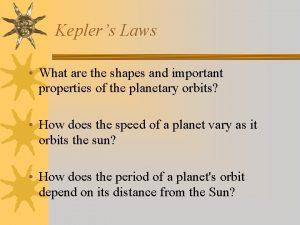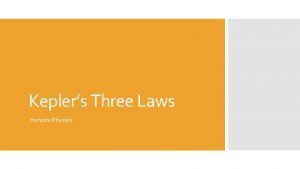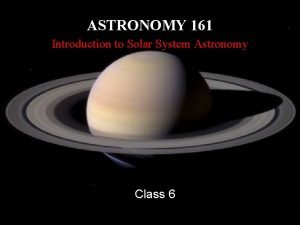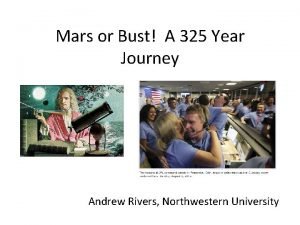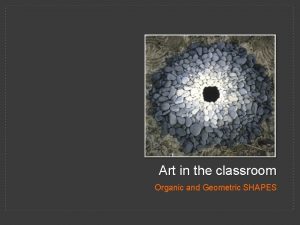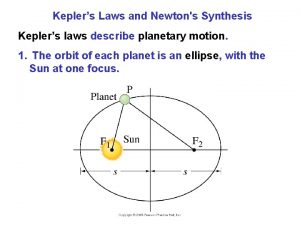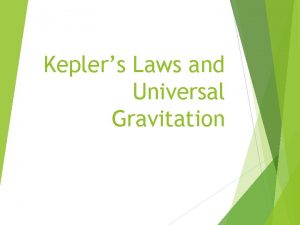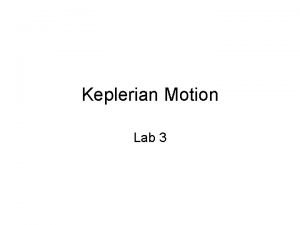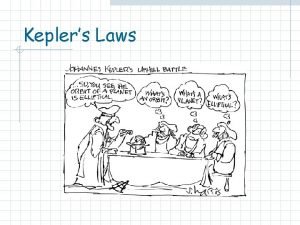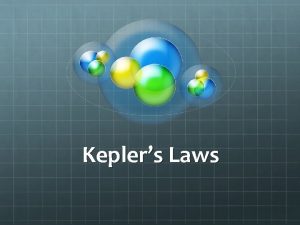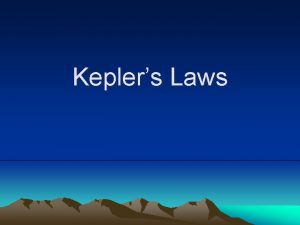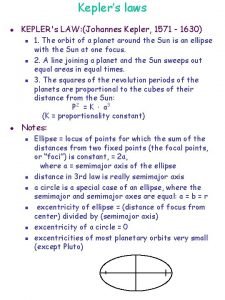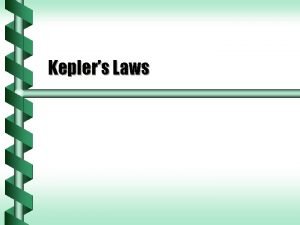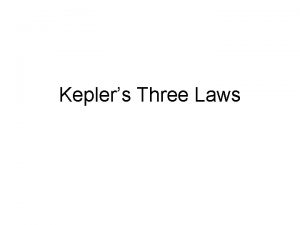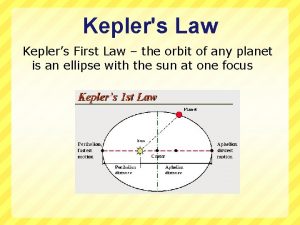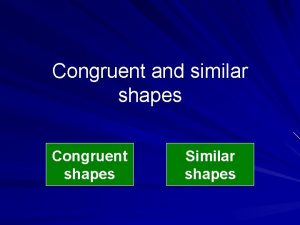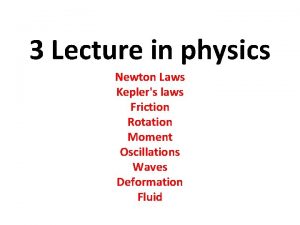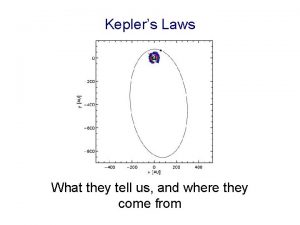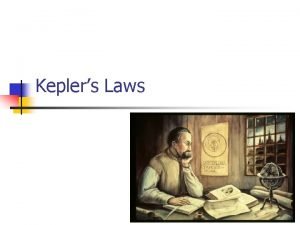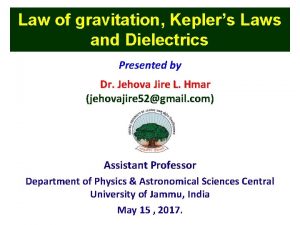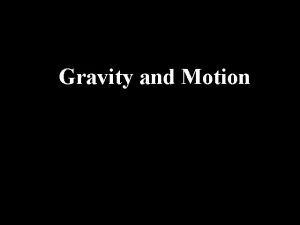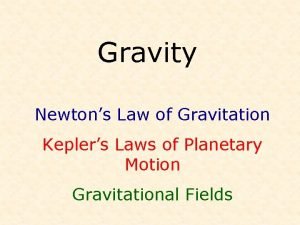Keplers Laws What are the shapes and important























- Slides: 23

Kepler’s Laws • What are the shapes and important properties of the planetary orbits? • How does the speed of a planet vary as it orbits the sun? • How does the period of a planet's orbit depend on its distance from the Sun?

Kepler’s First Law • The orbits of the planets are elliptical (not circular) with the Sun at one focus of the ellipse. • 'a' = semi-major axis: Avg. distance between sun and planet

Kepler’s Second Law ¬Kepler determined that a planet moves faster when near the Sun, and slower when far from the Sun. Planet Faster Sun Slower

Kepler's Second Law A line connecting the Sun and a planet sweeps out equal areas in equal times. slower faster Translation: planets move faster when closer to the Sun.

Kepler's Third Law The square of a planet's orbital period is proportional to the cube of its semi-major axis. P 2 is proportional to a 3 or P 2 (in Earth years) = a 3 (in A. U. ) 1 A. U. = 1. 5 x 108 km Translation: The further the planet is from the sun, the longer the period.

Correction to Kepler’s Third Law ¬ Earth and sun actually rotate about their common center of mass ¬ Corresponds to a point inside sun ¬ Used to detect extrasolar planets

Why? ¬Kepler’s Laws provided a complete kinematical description of planetary motion (including the motion of planetary satellites, like the Moon) - but why did the planets move like that?

The Apple & the Moon ¬Isaac Newton realized that the motion of a falling apple and the motion of the Moon were both actually the same motion, caused by the same force - the gravitational force.

Universal Gravitation ¬Newton’s idea was that gravity was a universal force acting between any two objects.

Gravitational Field Strength ¬To measure the strength of the gravitational field at any point, measure the gravitational force, F, exerted on any “test mass”, m. ¬Gravitational Field Strength, g = F/m

Gravitational Field Strength ¬Near the surface of the Earth, g = F/m = 9. 8 N/kg = 9. 8 m/s 2. ¬In general, g = GM/r 2, where M is the mass of the object creating the field, r is the distance from the object’s center, and G = 6. 67 x 10 -11 Nm 2/kg 2.

Gravitational Force ¬If g is the strength of the gravitational field at some point, then the gravitational force on an object of mass m at that point is Fgrav = mg. ¬If g is the gravitational field strength at some point (in N/kg), then the free fall acceleration at that point is also g (in m/s 2).

Gravitational Field Inside a Planet ¬If you are located a distance r from the center of a planet: – all of the planet’s mass inside a sphere of radius r pulls you toward the center of the planet. – All of the planet’s mass outside a sphere of radius r exerts no net gravitational force on you.

Gravitational Field Inside a Planet ¬The blue-shaded part of the planet pulls you toward point C. ¬The grey-shaded part of the planet does not pull you at all.

Gravitational Field Inside a Planet ¬Half way to the center of the planet, g has one-half of its surface value. ¬At the center of the planet, g = 0 N/kg.

Kepler’s Laws are just a special case of Newton’s Laws! ¬Newton explained Kepler’s Laws by solving the law of Universal Gravitation and the law of Motion ¬Ellipses are one possible solution, but there are others (parabolas and hyperbolas)

Kepler’s Laws are just a special case of Newton’s Laws! ¬Newton explained Kepler’s Laws by solving the law of Universal Gravitation and the law of Motion ¬Ellipses are one possible solution, but there are others (parabolas and hyperbolas)

Bound and Unbound Orbits Unbound (comet) Unbound (galaxy-galaxy) Bound (planets, binary stars)

Understanding Kepler’s Laws: conservation of angular momentum L = mv x r = constant r larger distance smaller v planet moves slower smaller distance smaller r bigger v planet moves faster

Understanding Kepler’s Third Law Newton’s generalization of Kepler’s Third Law is given by: p 2 = 4 p 2 a 3 G(M 1 + M 2) Mplanet << Msun, so p 2 = 4 p 2 a 3 GMsun

This has two amazing implications: ¬The orbital period of a planet depends only on its distance from the sun, and this is true whenever M 1 << M 2

An Astronaut and the Space Shuttle have the same orbit!

Second Amazing Implication: ¬If we know the period p and the average distance of the orbit a, we can calculate the mass of the sun!
 Kepler law
Kepler law Keplers three laws
Keplers three laws Mikael ferm
Mikael ferm Keplers phase funnel
Keplers phase funnel Keplers law
Keplers law Organic and geometric shapes
Organic and geometric shapes Facts about montesquieu
Facts about montesquieu From most important to least important in writing
From most important to least important in writing Inverted pyramid in news writing
Inverted pyramid in news writing Least important to most important
Least important to most important Hình ảnh bộ gõ cơ thể búng tay
Hình ảnh bộ gõ cơ thể búng tay Lp html
Lp html Bổ thể
Bổ thể Tỉ lệ cơ thể trẻ em
Tỉ lệ cơ thể trẻ em Chó sói
Chó sói Glasgow thang điểm
Glasgow thang điểm Chúa sống lại
Chúa sống lại Các môn thể thao bắt đầu bằng từ đua
Các môn thể thao bắt đầu bằng từ đua Thế nào là hệ số cao nhất
Thế nào là hệ số cao nhất Các châu lục và đại dương trên thế giới
Các châu lục và đại dương trên thế giới Công của trọng lực
Công của trọng lực Trời xanh đây là của chúng ta thể thơ
Trời xanh đây là của chúng ta thể thơ Mật thư tọa độ 5x5
Mật thư tọa độ 5x5 101012 bằng
101012 bằng
